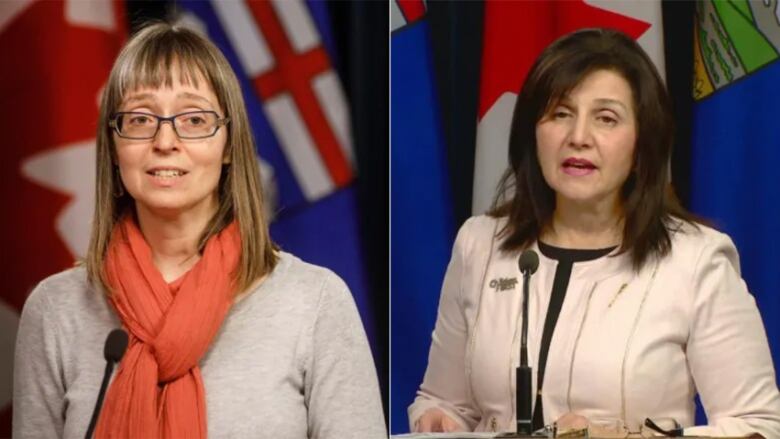Alberta focused on return to 'near-normal' classes to start 2020-21 school year
'Based on the information we have at hand right now, we expect that students will be at school in September'

The Alberta government is targeting a return to"near-normal" conditions with students returning to classrooms across the province for the beginning of the 2020-21 school year, Education Minister Adriana LaGrange says.
"Our goal is to get us back to normal learning assoon as possible,"LaGrange said Wednesday atnews conference."We are targeting a returnto new-normal operations with some health measures in place."
LaGrange laid out three scenarios that have been part of the planning for weeks now.
Thefirst scenario would see near-normal operations resume with students returning to daily in-school classes with some health measures. Under the second scenario, in-school classes would only resume partially with additional health requirements. The third scenario would see at-home learning continue.
A final decision on school openings will be made Aug. 1, she said.
"Based on the information we have at hand right now, we expect that students will be at school in September," LaGrange said.
Plan must be 'flexible and nimble'
All school boards will have to be ready to transition from one scenario to another on short notice to adapt to any changes in the COVID-19 situation, she said.
"How we return to in-class learning may vary regionally and will depend on the number of COVID 19 cases in total in that area," LaGrange said. "The reality is that the COVID-19 environment requires all of us to be flexible and nimble, flexible throughout the next school year."
The decision about which scenarios tofollow will be made by the government based on public-health guidance, the minister said, not by local school boards.
Thatwill help the provinceensure that all schools adhere to the appropriate health measures for their region.
"While things will not be exactly as they were before the pandemic, students will be back learning in an environment they know," she said.
Since schools closed down in March, LaGrange said, teachers, school board and parents have done their best to adapt to different ways to help students learn at home, LaGrange said.
"We all know, though, that students learn best in the classroom with their teachers and their peers, provided that it's safe to do so."
New guidelines
Dr. Deena Hinshaw, Alberta's chief medical officer of health, said the government's re-entry plan schools tried to find a balance, given that there are consequences to having children learn at home rather than in schools.
"We know that there are risks to those children;we know that there are consequences to broader society to having a universal distance-delivered education model," she said. "So we need to balance the risks of continuing that distance model or the risks of bringing students back to school, because there is no one risk-free option that we have at our disposal, unfortunately."
Physical distancing may be more challenging foryounger children, she said. Health officials have made recommendationsto limit transmission, includingre-arrangingdesks, restructuring activities, keepingchildrenin cohorts and relyingonhealth screenings, Hinshawsaid.
The government's guide for school re-entry under scenario one includes several specific recommendations, including:
- Cohorting Where possible, students should be cohorted by class, with the size of the cohort dependent on the physical space of the classroom.
- Physical distancing Where two metres is not possible between desks, students should be arranged so they do not face each other, for example, seated in rows rather than in small groups or semi-circles. When two metres is not possible,especially if circumstances requireclose contact for longer that 15 minutes, teachers, staff and students may choose to wearnon-medical face masks.
- Pick up/drop off The guide recommendsstaggering drop-off and pick-up times and locationsor using other ways to limit contact between staff, parents and students as much as possible.
- Transportation Students should be assigned seats and a record of the seating plan should be kept to assist with contact tracing if a student contractsCOVID-19. Students who live in the same household should be seated together. Field trips and activities requiring group transportation should be postponed.
- Food and dining Stagger lunch and snack breaks to maintain physical distancing. No activities that involve the sharing of foodshould occur. For classroom meals or snacks, no self-serve or family-style meals. Schools shouldswitch to pre-packaged meals or meals served by designated staff. Food provided by the family should be stored with the student's belongings.
Latest numbers
The province conducted 6,582 tests for COVID-19 over the past 24 hours and identified47 new cases, for a total of 371 active cases across the province, Hinshaw said.
Of the 47 new cases, 22 are in the Edmonton zone. Since June 1, Edmonton zone has gone from 44 active cases to 134 as of Wednesday's update. Calgary zone still has the most active cases in province with203.
As of Wednesday, 42people were in hospital being treated for the illness, six of them in ICU beds.
No more deaths were reported, leaving thetotal at151.
Hinshaw reported a small outbreak at Alberta Hospital in Edmonton, wherefour staff members have tested positive. No patients have tested positive, she said.
Premier Jason Kenney announced on Tuesday that Stage 2 of the province's relaunch plan will begin Friday, allowing more businesses and services to reopen with two-metre physical distancing requirements and other public health measures in place.












_(720p).jpg)


 OFFICIAL HD MUSIC VIDEO.jpg)
.jpg)



























































































